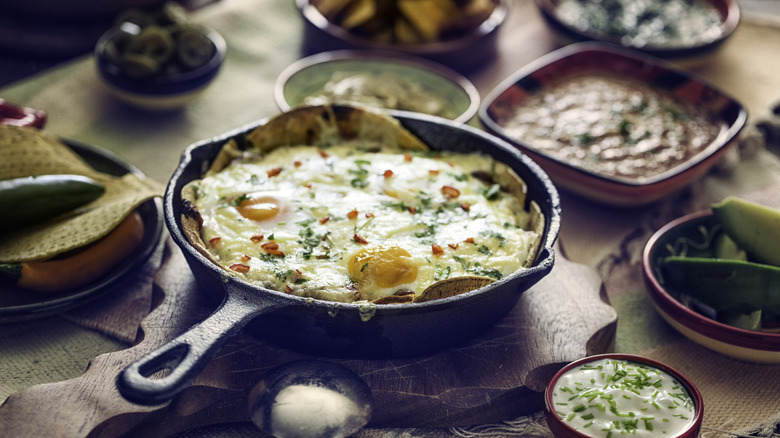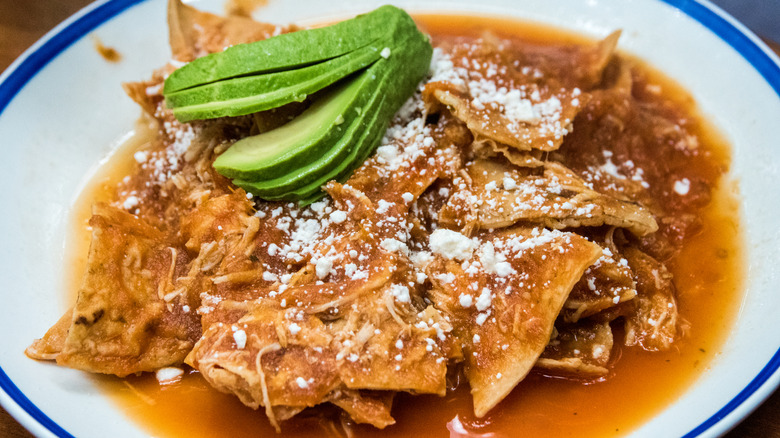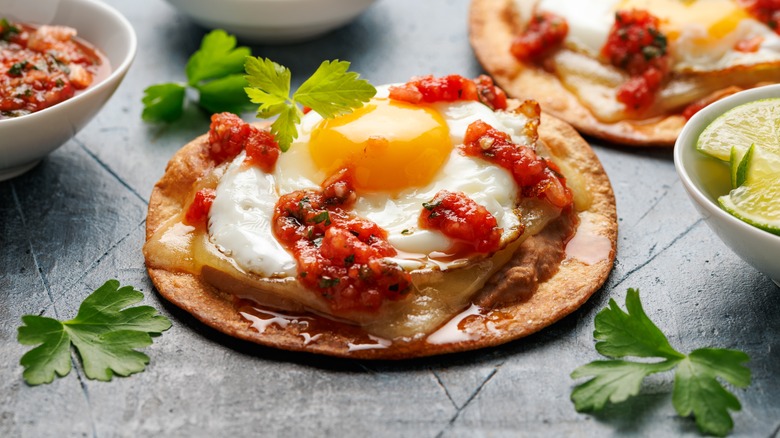Chilaquiles Vs Huevos Rancheros: What Are The Differences?
We may receive a commission on purchases made from links.
If you've ever found yourself staring at a Mexican brunch menu trying to decide between ordering chilaquiles and huevos rancheros, you're not alone. These flavorful dishes are iconic in Mexican cuisine, but despite their similarities, there are some important differences between them.
Chilaquiles start with crispy tortilla pieces (either fried or baked), which are then sautéed in red or green salsa until they're just a little floppy. They're often served with eggs, cheese, and sometimes proteins like shredded chicken, salchichón (sausage), or fresh Mexican chorizo. On the other hand, huevos rancheros are essentially fried eggs served on top of tortillas and then topped with tomato-chili salsa. This dish can also be loaded with additional ingredients, such as beans, avocado, and cheese. Both are primarily served for breakfast (although we won't pass them up any time of day).
While it's common for chilaquiles to include eggs, it's not a required part of the dish. However, eggs are a must with huevos rancheros (it's literally in the name). It's important to note the different roles salsa plays, as well — in chilaquiles, it's meant to soak into the tortillas to soften them, but the salsa in huevos rancheros is more of a condiment to complement the meal. This gives chilaquiles more of a casserole-style texture than huevos rancheros. Although these dishes have different preparations and histories, they're both great examples of the colorful world of Mexican breakfasts.
Chilaquiles have Aztec origins
A recipe for chilaquiles has the interesting distinction of appearing in the first cookbook penned by a Hispanic writer in the U.S. — 1898's "El Cocinero Español (The Spanish Cook)," which is now published as "Encarnación's Kitchen." However, the origins of chilaquiles are way older than that, going all the way back to Aztec times, with the word "chilaquiles" coming from the Nahuatl language.
Corn was an essential crop for ancient Indigenous peoples in the Americas, and the Aztecs often ate it in the form of tortillas. It's believed that chilaquiles first developed as a way to use up leftover tortillas so they didn't go to waste. Since the dish involves saturating the flatbread in a sauce, it works perfectly with food that has gotten a little stale.
However, any Aztec version of chilaquiles would have been very different from how it's prepared today, because frying wasn't introduced as a cooking method in the region until the Spanish conquest in the 16th century. The Spaniards also brought new spices and other ingredients from Europe, like garlic, onions, chicken eggs, and dairy. These influences continued to shape the regional cuisine and led to modern versions of Mexican chilaquiles.
Huevos rancheros got their start on Mexican ranches
"Huevos rancheros" essentially means "ranch-style eggs," a reference to the dish's origins as a traditional meal on Mexican ranches. While corn tortillas and salsa are regional staples going back to pre-Hispanic times, eggs only became popular after chickens were introduced by the Spanish.
Hunting down the exact origins of huevos rancheros is a bit tricky. The Oxford English Dictionary says the first known use of the word occurred in 1901. In the 20th century, as Mexico's cities became more developed and populated, recipes from rural areas of the country made their way to urban areas, and a new demographic embraced them. Mexican cuisine and culture made their way into the U.S. through places like California and Texas.
For example, huevos rancheros became a favorite dish in San Antonio, as it's right on the Texas-Mexico border. (In fact, prior to becoming a U.S. state, Texas was a Spanish colony that came under the rule of a newly independent Mexico in the 19th century.) After the dish hit the U.S., Americans adapted it to their tastes. They added elements like bacon, lettuce, and potatoes. With their emphasis on fresh ingredients and simple preparation, it's no wonder huevos rancheros are a beloved staple in Mexico and beyond.


